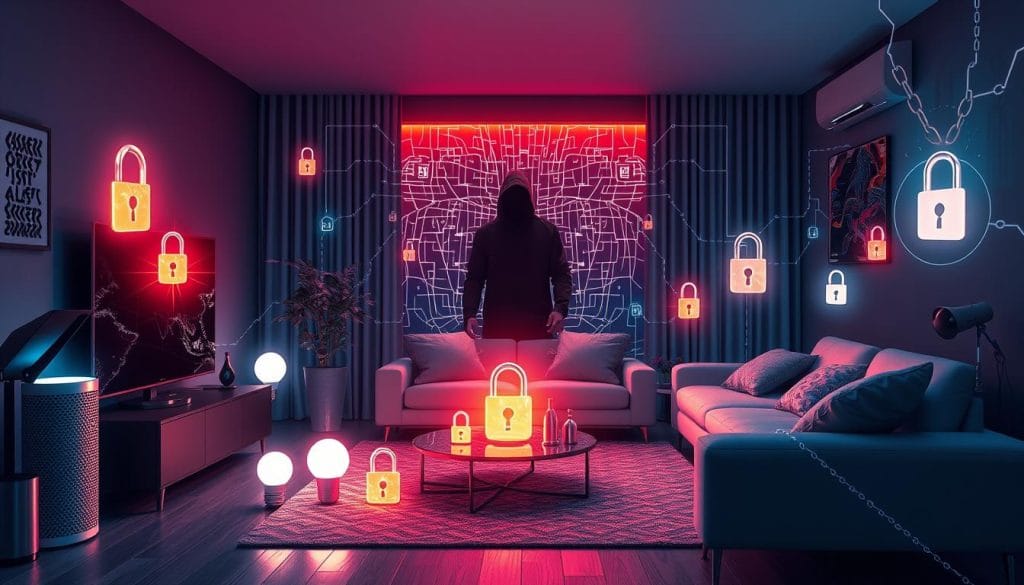When it comes to smart home technology, creating engaging educational content is crucial for effective communication. With the rise of smart home technology, it’s essential to avoid common mistakes that can lead to disengagement and decreased learning outcomes. By incorporating engaging educational content, individuals can enhance their learning experience and develop a deeper understanding of smart home technology.
Imagine being able to control your home’s lighting, temperature, and security with just the touch of a button. Smart home technology makes this possible, but it requires a solid understanding of how to use it effectively. By avoiding common mistakes and creating engaging educational content, individuals can unlock the full potential of smart home technology and enjoy the benefits of convenience, energy efficiency, and security.
Key Takeaways
- Avoiding common mistakes is crucial for effective smart home technology implementation
- Engaging educational content can enhance the learning experience and promote active participation
- Smart home technology offers numerous benefits, including convenience, energy efficiency, and security
- Incorporating students’ prior knowledge and interests can boost engagement levels in learning environments
- Properly structured instructional design is essential for creating impactful courses and maximizing student learning outcomes
- Integrating modern technology in teaching practices can promote active student engagement and improve learning outcomes
By following these key takeaways and avoiding common mistakes, individuals can create engaging educational content that promotes active learning and unlocks the full potential of smart home technology. With the right approach, smart home technology can be a powerful tool for enhancing daily life and promoting convenience, energy efficiency, and security.
Understanding the Smart Home Revolution
The smart home revolution is transforming the way we live and interact with our living spaces. With the rise of home automation, consumers are experiencing increased convenience, energy efficiency, and comfort. According to recent market trends, the global smart home market is projected to grow from $79 billion in 2022 to $135 billion by 2025, indicating a compound annual growth rate (CAGR) of approximately 25.6%.
One of the key drivers of the smart home revolution is the integration of AI in home devices, which improves their operational efficiency by up to 30% compared to traditional home appliances. Additionally, voice control is expected to be a major factor driving smart home adoption, with over 50% of users preferring to interact with their devices through voice commands. Some of the benefits of smart homes include:
- Increased convenience and comfort
- Energy efficiency and cost savings
- Enhanced security and safety
As the smart home market continues to grow, it’s essential to stay informed about the latest market trends and statistics. With approximately 70% of smart home device users reporting that they appreciate the convenience added by voice assistants in managing their devices, it’s clear that the smart home revolution is here to stay.
Incompatible Device Selection: A Critical Oversight
When setting up a smart home, one of the most critical decisions is device selection. Choosing incompatible devices can lead to a frustrating experience, rendering your smart home devices useless. To avoid this mistake, it’s essential to research and compare different devices before making a purchase.
A well-planned device selection process involves considering factors such as compatibility, functionality, and scalability. Smart home devices from reputable brands like Samsung, Apple, and Google are often designed to work seamlessly together, making it easier to create a cohesive and efficient smart home system.
Some key considerations for incompatible devices include:
- Checking the device’s compatibility with your existing smart home system
- Reading reviews and ratings from other users to ensure the device meets your needs
- Considering the device’s scalability and potential for future updates
By taking the time to carefully evaluate your device selection, you can avoid the pitfalls of incompatible devices and create a smart home system that is both functional and enjoyable to use. With the right smart home devices, you can experience the full benefits of a connected and convenient living space.

Remember, a well-planned device selection is crucial to creating a seamless and efficient smart home experience. By choosing compatible smart home devices, you can ensure that your system works together harmoniously, providing you with a convenient and enjoyable living space.
| Device Type | Compatibility | Scalability |
|---|---|---|
| Smart Thermostat | Works with Apple HomeKit and Google Assistant | Supports future updates and expansions |
| Smart Lighting | Compatible with Samsung SmartThings and Amazon Alexa | Allows for easy addition of new devices |
The Impact of Weak Network Infrastructure
A strong network infrastructure is crucial for a smart home setup, as it ensures reliable and secure connectivity for all devices. A weak network infrastructure, on the other hand, can lead to poor Wi-Fi coverage, compromising the overall performance of smart devices. Network security is also a significant concern, as a weak infrastructure can leave devices vulnerable to cyber threats.
To ensure a strong network infrastructure, it’s essential to consider Wi-Fi coverage and network security. This can be achieved by investing in a reliable router, using Wi-Fi extenders, and implementing robust security measures, such as firewalls and antivirus software. Additionally, regular network maintenance and updates can help prevent disruptions and ensure optimal performance.
- Assessing bandwidth requirements for smart devices
- Implementing network security fundamentals, such as encryption and access controls
- Ensuring reliable Wi-Fi coverage throughout the home
By prioritizing network infrastructure, smart home owners can enjoy a seamless and secure connected experience.
| Network Infrastructure Considerations | Importance |
|---|---|
| Wi-Fi Coverage | High |
| Network Security | High |
| Bandwidth Requirements | Medium |
Creating Engaging Educational Content for Smart Home Success
When it comes to creating engaging educational content for smart home success, it’s essential to focus on content creation that educates and entertains. This can be achieved by incorporating storytelling, interactive elements, and visuals into your content. For instance, using animation can simplify complex topics, making them easier to understand for viewers. Additionally, incorporating live Q&A sessions can increase real-time interactivity, fostering a community feel among viewers.
To create effective engaging educational content, consider the following tips:
- Keep training sessions short and structured, with core instruction blocks under 15 minutes and structured breaks every 45-60 minutes.
- Incorporate multiple learning modes to increase retention rates.
- Use visual elements to reduce comprehension time and improve retention.
By following these tips and focusing on smart home success, you can create engaging educational content that drives results. As noted by experts, incorporating multiple 15-minute blocks into a 45-60 minute training session can significantly improve learner satisfaction scores. Furthermore, using assessments strategically can reinforce learning and build critical thinking skills, ultimately leading to smart home success.
By prioritizing content creation and incorporating engaging elements, you can increase engagement and drive smart home success. Remember to review your training content quarterly for relevance and engagement, and utilize various engaging video formats to cater to different learning styles.
| Content Type | Retention Rate | Engagement Metric |
|---|---|---|
| Interactive Content | 38% improvement | 2x better than passive material |
| Visual Elements | 40% reduction in comprehension time | 50% improvement in retention |
Security Vulnerabilities in Smart Home Systems
Smart home systems have become increasingly popular, but they also introduce new security vulnerabilities. Approximately 72% of consumers express worry or strong concern regarding the security of their personal data collected and transmitted by smart home devices, according to Parks Associates. The integration of multiple smart home devices from different manufacturers can lead to varying levels of security protection, increasing vulnerability within the ecosystem.
The average smart home is exposed to a high number of data attacks, with reported instances highlighting concerns over unauthorized access and control of devices. Weak authentication mechanisms, including the prevalence of default passwords, pose significant risks for unauthorized access to smart home devices. Unencrypted communication protocols used by many smart home devices leave sensitive data vulnerable to interception and manipulation.
Common Security Breaches
Smart home attacks include incidents where hackers have remotely controlled devices such as smart lights, smart TVs, and IoT-enabled doors. An alarming number of smart home devices remain running outdated firmware, which may contain known vulnerabilities that hackers can exploit. The lack of robust security features in smart devices leaves them susceptible to exploitation by cybercriminals.
Prevention Strategies
To prevent security breaches, it is essential to implement robust security measures, such as regularly updating firmware and using strong passwords. Additionally, smart home owners should be aware of the potential risks associated with smart home devices and take steps to mitigate them. This can include using encryption protocols and implementing regular maintenance protocols to ensure the security of their smart home systems.

Regular Maintenance Protocols
Regular maintenance protocols are crucial in preventing security breaches. This can include regularly updating software and firmware, monitoring device activity, and implementing robust security measures. By taking these steps, smart home owners can help protect their devices and prevent security vulnerabilities. The following table highlights some key security measures that can be taken:
| Security Measure | Description |
|---|---|
| Regularly update firmware | Ensure that all devices are running the latest firmware to prevent exploitation of known vulnerabilities |
| Use strong passwords | Use unique and complex passwords for all devices to prevent unauthorized access |
| Implement encryption protocols | Use encryption protocols to protect sensitive data and prevent interception and manipulation |
Overcomplicating Your Smart Home Setup
When it comes to creating a smart home setup, simplicity is key. Many individuals fall into the trap of overcomplicating their setup, which can lead to frustration and decreased functionality. A smart home setup should be intuitive and easy to use, allowing users to control their devices with ease.
To avoid overcomplicating your smart home setup, consider the following tips:
- Start with a simple setup and gradually add devices as needed
- Choose devices that are compatible with each other and your smart home hub
- Use a centralized control system to manage all your devices
By keeping your smart home setup simple, you can ensure that it is easy to use and maintain. This will also help to prevent issues with device compatibility and reduce the risk of technical problems. Some popular smart home devices, such as those from Apple and Amazon, offer simple and intuitive interfaces that make it easy to control your smart home setup.
Additionally, consider using a platform like Homebridge to integrate non-HomeKit devices into your Apple HomeKit. This can help to simplify your setup and reduce the number of devices you need to manage. By following these tips, you can create a smart home setup that is both functional and easy to use, without overcomplicating it.
Remember, the goal of a smart home setup is to make your life easier and more convenient. By keeping your setup simple and intuitive, you can ensure that it meets your needs and provides you with the benefits you’re looking for. Don’t fall into the trap of overcomplicating your smart home setup – keep it simple and enjoy the convenience and functionality it provides.
| Device | Compatibility | Ease of Use |
|---|---|---|
| Apple HomeKit | High | Easy |
| Amazon Alexa | High | Easy |
| Homebridge | High | Medium |
Future-Proofing Your Smart Home Investment
As the smart home market continues to grow, with a projected size of approximately $174 billion by 2025, it’s essential to consider future-proofing your smart home investment. This involves thinking about scalability and how your devices will integrate with emerging technologies. A smart home investment is not just about the initial cost, but also about the long-term benefits and potential for expansion.
When planning your smart home setup, consider the importance of scalability. This means choosing devices that can be easily integrated with other products and systems, allowing you to add new features and technologies as they become available. For example, devices that adhere to open standards like Matter are expected to account for more than 50% of total smart home device sales by 2024, making them a good choice for future-proofing.
Scalability Considerations
To ensure your smart home investment is scalable, consider the following factors:
- Device compatibility: Choose devices that can integrate with other products and systems.
- Open standards: Opt for devices that adhere to open standards like Matter.
- Wireless connectivity: Consider devices with wireless connectivity options like WiFi 6 or WiFi 7 mesh routers.
Emerging Technologies to Watch
Some emerging technologies to watch in the smart home space include voice-controlled smart home hubs, energy-efficient devices, and devices with advanced security features. By staying informed about these emerging technologies, you can make informed decisions about your smart home investment and ensure it remains relevant and effective in the long term.
| Technology | Description |
|---|---|
| Voice-controlled smart home hubs | Central control points for smart home ecosystems |
| Energy-efficient devices | Devices that consume less energy, such as LED bulbs |
| Advanced security features | Features like encryption and two-factor authentication |
Expert Recommendations for Optimal Performance
For a smart home to function at its best, it’s essential to follow expert recommendations for optimal performance. This includes investing in professional installation to ensure all devices are connected and working seamlessly together. By doing so, homeowners can enjoy the full benefits of their smart home system, from enhanced convenience to increased energy efficiency.
Some key tips for optimal performance include regular software updates, proper device placement, and a stable internet connection. Additionally, homeowners can benefit from regular maintenance checks to identify and address any issues before they become major problems. By following these expert recommendations, homeowners can enjoy a smart home that is both efficient and effective.
For those looking to take their smart home to the next level, consider the following best practices:
- Invest in a professional installation to ensure a stable and secure connection
- Regularly update software and firmware to ensure devices are running with the latest features and security patches
- Monitor energy usage and adjust settings to optimize efficiency
By following these expert recommendations and best practices, homeowners can enjoy optimal performance from their smart home system, and reap the benefits of a more convenient, efficient, and connected living space.
| Best Practice | Benefits |
|---|---|
| Professional Installation | Stable and secure connection, optimal performance |
| Regular Software Updates | Latest features and security patches, improved efficiency |
| Energy Monitoring | Optimized energy usage, cost savings |
Conclusion: Building a Smarter, More Connected Home
As we’ve explored, creating engaging educational content is key to the widespread adoption and success of smart home technology. By providing clear, visually-appealing resources that demonstrate the benefits of a , homeowners can overcome the initial hurdles and embrace the convenience, energy efficiency, and security that a offers.
Whether it’s through interactive tutorials, informative videos, or carefully curated product guides, the emphasis should be on empowering users to seamlessly integrate smart devices into their daily lives. By addressing common concerns like compatibility, network infrastructure, and security vulnerabilities, you can build trust and confidence in smart home solutions.
As we look to the future, the possibilities for a are endless. By staying informed about emerging technologies and trends, homeowners can future-proof their investments and ensure their smart home evolves with their needs. With the right guidance and support, the smart home revolution can truly transform the way we live, work, and relax in our own personal sanctuaries.
FAQ
What is the purpose of this article?
What is the smart home revolution?
What is the common mistake of selecting incompatible devices for a smart home setup?
Why is a strong network infrastructure important for a smart home setup?
How can engaging educational content contribute to smart home success?
What are the security vulnerabilities in smart home systems?
What is the common mistake of overcomplicating a smart home setup?
How can you future-proof a smart home investment?
What are the expert recommendations for optimal performance and maintenance best practices?
Source Links
- http://www.3plearning.com/blog/20-student-engagement-strategies-captivating-classroom/
- https://raccoongang.com/blog/how-engage-students-learning/
- https://ulse.org/news/mark-trust-how-standards-anchor-smart-home-revolution
- https://edu.ieee.org/eg-guc/2024/01/17/the-ai-revolution-in-education-a-game-changer-for-learning/
- https://www.walterpack.com/en/artificial-intelligence-and-design-keys-to-the-smart-home-revolution/
- https://www.ed.gov/sites/ed/files/policy/gen/guid/school-discipline/guiding-principles.pdf
- https://www.oecd.org/content/dam/oecd/en/publications/reports/2024/04/reimagining-education-realising-potential_fa0b99ab/b44e2c39-en.pdf
- https://www.linkedin.com/pulse/common-infrastructure-problems-faced-todays-schools-how-martin-jones
- https://pmc.ncbi.nlm.nih.gov/articles/PMC9684747/
- https://www.continu.com/blog/make-training-content-engaging
- https://www.linkedin.com/pulse/youtube-educators-creating-engaging-educational-content-david-o-noah-gan1e
- https://www.canarytrap.com/blog/smart-homes-security/
- https://engineering.nyu.edu/news/new-research-reveals-alarming-privacy-and-security-threats-smart-homes
- https://news.umich.edu/hacking-into-homes-smart-home-security-flaws-found-in-popular-system/
- https://www.transcenda.com/insights/smart-home-platforms-inclusive-product-design-can-be-your-competitive-edge
- https://ohmyfacts.com/technology/30-facts-about-homebridge/
- https://news.ycombinator.com/item?id=28085887
- https://www.transcenda.com/insights/future-proofing-your-smart-home-platform-building-for-scalability-and-long-term-relevance
- https://www.techguide.com.au/news/smart-home/best-strategies-for-future-proofing-your-smart-home/
- https://agilitycms.com/resources/posts/the-importance-of-future-proofing-your-content
- https://learningcenter.unc.edu/tips-and-tools/studying-101-study-smarter-not-harder/
- https://teachingcommons.stanford.edu/teaching-guides/foundations-course-design/learning-activities/increasing-student-engagement
- https://cft.vanderbilt.edu/guides-sub-pages/effective-educational-videos/
- https://explorance.com/blog/7-reasons-students-need-technology-classroom/
- https://www.gettingsmart.com/2017/11/07/closing-the-digital-divide-to-ensure-the-future-of-learning/
